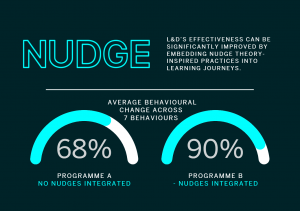HPC’s Kevin Hannigan reflects on how small nudges can drive large-scale behavioural change and help produce metrics that convince senior management that L&D’s work is producing effective results.
Most L&D professionals would probably agree that it can be hard to define and illustrate the true value they bring to their organisation. While other business functions like Marketing, Manufacturing or Sales can report solid metrics and easily identifiable KPIs, people-development is more nuanced.
This creates two distinct problems for L&D professionals. Firstly, how do we convince senior management that we are creating value in the organisation so that they allocate the necessary resources to L&D? Secondly, if we can’t measure impact, how do we know which, if any, of our approaches is delivering results
Over the past few years, we have worked with our clients to pioneer new approaches to demonstrating impact. As well as supporting the business case for greater investment in L&D, this data driven approach has also allowed us to identify specific tools that accelerate the transfer of learning and drive behavioural change.
The tool that we will discuss in this article is based on Nudge Theory. Our experience is that combining Nudge Theory with our approach to design and learning transfer has increased behavioural change for our clients.
What is Nudge Theory?
Popularised by the 2008 book, ‘Nudge: Improving Decisions About Health, Wealth, and Happiness’, by Thaler and Sunstein, Nudge theory proposes that the most effective ways to influence the behaviour and decision-making of groups or individuals are through positive reinforcement and indirect suggestions. In this way, nudging contrasts with other ways to influence behaviour such as education, legislation or enforcement. Thaler and Sunstein put it best in their book as follows:
“To count as a mere nudge, the intervention must be easy and cheap to avoid. Nudges are not mandates. Putting fruit at eye level counts as a nudge. Banning junk food does not.”
Nudging in L&D
So, what might a nudge look like in L&D? Based on Thaler and Sunstein’s idea, it really could be any tool that suggests a way of behaving or performing or any way that reinforces learning. It could be a reminder or a conversation with someone. Think of nudges as an ecosystem of reminders to help people make better choices post-training.
Nudging in Practice
Over the past two years, we have been working closely with our clients to help them assess the impact of specific leadership development programmes. For the purposes of this article, we have selected two programmes with a similar audience profile and similar organisational contexts. Both programmes were different in scope and subject matter, but at their core, both were focused on recalibrating leadership in their respective organisations. From team engagement and the deployment of coaching, to creating an accountability culture and embedding values in everyday conversations, these programmes were carefully designed to create an environment where people could perform to their potential.
A critical difference in programme design was the use of nudges. In one programme, participants received a series of nudges between programme modules and in the 3 months following the programme. These nudges were a series of prompts that reconnected participants with key concepts from the programme and prompted them to act. The second programme did not use nudges.
Findings and Insights
The results spoke volumes and showed that the practical application of behavioural science can play a crucial role in modern L&D.
On both programmes, we assessed behaviour 12 weeks after the workshops had completed and compared the results with a pre-programme benchmark.

The programme without nudges demonstrated an average shift of 68% across seven behaviours i.e. more than two thirds of participants had changed their behaviour following the completion of the programme. For the programme with nudges, the corresponding figure was an average of 90% across seven similar behaviours i.e. 9 in 10 participants had shifted their behaviour.
When we asked people about the impact of the nudges, more than 80% of participants indicated that the nudges had reminded them of key concepts from the programme and had prompted them to try new things.
Nudge Theory in your L&D programme
So, how might you start incorporating Nudge Theory into your programme design? We believe there are three initial steps you can take:
- Identify the critical behaviours you want to change – focus on what you want participants to do and how they will do this.
- Consider a basic nudge framework – nudges should be straightforward, accessible and timely. Consider how to get to learners in a simple way that prompts them to try something different.
- Experiment and track – ultimately, you need to try different approaches and track results. This will allow you to build your case internally for increased resources or specialist help.
We know that programmes on their own are rarely enough. To drive measurable change and organisational performance, we need a strategic approach to learning transfer. Using nudges as part of your learning architecture may just be the additional tool you need to demonstrate value to your senior stakeholders.

Kevin Hannigan leads the Learning and Talent Consulting offering and is also a Client Director at HPC. He works with clients to develop, deliver and evaluate bespoke solutions that drive performance across their business.
He is a highly skilled consultant and facilitator with a wealth of experience in designing the systems and processes that support effective learning, measurement and talent development.
Before joining HPC in 2013, Kevin was head of learning and development for Matheson, Ireland’s largest law firm and for C&C Ireland.